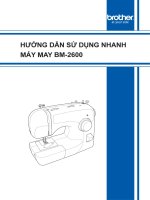care label symbols Nhãn Hướng Dẫn Sử Dụng Ngành May
Bạn đang xem bản rút gọn của tài liệu. Xem và tải ngay bản đầy đủ của tài liệu tại đây (58.68 KB, 2 trang )
As of July 1,1997, care labels may come with a new feature — symbols or pictures. These symbols will quickly help you
determine how to clean your clothes. Through 1998, the care label must include written instructions with the option of
using symbols as well. After 1998, either written instructions or symbols must be provided, but not always both. Below
is a quick guide to help you learn the new symbols.
Agricultural Extension Service
The University of Tennessee
Wash
Bleach
Dry
Iron
Dryclean
A
P
F
Dryclean - Normal Cycle
Machine
Wash
Cycles
Normal
Permanent
Press
Delicate/
Gentle
Water
Temperatures
(Maximum)
Symbol(s)
(200F)
(160F)
(140F)
(120F)
(105F) (65F-85F)
95C
70C
60C
50C
40C
30C
Any Bleach
When Needed
Only Non-Chlorine Bleach
When Needed
Tumble Dry
Cycles
Normal
Permanent
Press
Delicate/
Gentle
Line Dry /
Hang to Dry
Drip Dry
Dry Flat
Tumble Dry
Settings
Any Heat
High
Medium
Low
No Heat/Air
Iron —
Dry or Steam
Maximum
Temperatures
200C
(390F)
High
150C
(300F)
Medium
110C
(230F)
Low
Any
Solvent
Any Solvent
Except
Trichloroethylene
Petroleum
Solvent
Only
Do Not
Dryclean
Dryclean — Additional Instructions
Short
Cycle
Reduced
Moisture
Low
Heat
No
Steam
Finishing
Hand Wash
Warning
Symbols
Do Not Wash
Do Not Bleach
Do Not Dry
(used with
Do Not Wash)
Do Not
Tumble Dry
Do Not Wring
In the shade
(added to line dry,
drip dry or dry flat)
Do Not Iron
No Steam
(added to iron)
Guide to Apparel/Textile Care Symbols
As a minimum, laundering instructions include, in order, four symbols: washing, bleaching, drying and ironing.
Drycleaning instructions include one symbol.
Care Label Symbols
Bridgett W. Smith, Associate Professor
Clothing, Housing & Environmental Stewardship
SP519
What is the Care Labeling Rule?What is the Care Labeling Rule?
What is the Care Labeling Rule?What is the Care Labeling Rule?
What is the Care Labeling Rule?
The Care Labeling Rule was issued by the Federal Trade Commission in 1971 to help consumers with clothing
care. The rule states that manufacturers must tag their clothing with at least one safe cleaning method. Beginning
July 1, 1997, manufacturers may use certain care symbols in place of words on labels. These symbols and their
meanings are explained on the reverse side of this publication. Symbols and their written meaning will be required
for eighteen months. After January 1998, only symbols can be used by the manufacturer.
What information is required on the care label?What information is required on the care label?
What information is required on the care label?What information is required on the care label?
What information is required on the care label?
Care labels for textile wearing apparel must provide either washing or dry cleaning instructions. Only one safe
method of care is required to be provided by the manufacturer. The label must also warn you against any
procedure that might harm the item during reasonable care. For example, the label must say whether any step of
the care method — washing, bleaching, drying, ironing or dry cleaning — could harm the garment or other
garments cleaned with it.
Are there any other symbols?Are there any other symbols?
Are there any other symbols?Are there any other symbols?
Are there any other symbols?
The symbols shown on the reverse side of this publication are approved for use throughout North America. There
is not an internationally recognized care label system at the present time. Clothing manufactured in countries
outside North America may use different symbols.
Does washable also mean my garment can be dry cleaned?Does washable also mean my garment can be dry cleaned?
Does washable also mean my garment can be dry cleaned?Does washable also mean my garment can be dry cleaned?
Does washable also mean my garment can be dry cleaned?
Not always. Only one safe method of care has to be listed on the label by the manufacturer. The label does not
have to warn about other cleaning methods which might prove unsafe. For example, clothing labeled “washable”
may not dry clean well.
What if the care instructions don’t work?What if the care instructions don’t work?
What if the care instructions don’t work?What if the care instructions don’t work?
What if the care instructions don’t work?
If you followed the care instructions on the label and problems result, return it to the store where you bought it.
Dyes that run after following the the manufacturer’s washing instructions and other problems which result are the
responsibility of the manufacturer. The safe cleaning method listed on the care label is, in effect, a care warranty.
Ask the store for an exchange or refund. If the store will not help you, ask for the manufacturer’s name and
address and write directly to the company, describing your problem.
You can also contact the Federal Trade Commission by writing to: Consumer Response Center, Federal Trade
Commission, Washington, DC 20580. Although the FTC cannot resolve individual disputes, the information you
provide may indicate a pattern of law violations requiring action by the Commission.
Other publications by The University of Tennessee Agricultural Extension Service:
PB 1301 Spot and Stain Removal
PB 1517 Machine Wash vs. Dry Clean Only
PB 1518 Understanding Care Labels
PB 1207 Care and Storage of Textile Heirlooms
To request a copy of any of the above publications, please contact your county Extension office.
Frequently Asked Questions
A State Partner in the Cooperative Extension System
The Agricultural Extension Service offers its programs to all eligible persons regardless of race, color, age, national origin, sex
or disability and is an Equal Opportunity Employer. COOPERATIVE EXTENSION WORK IN AGRICULTURE AND HOME ECONOMICS
The University of Tennessee Institute of Agriculture, U.S. Department of Agriculture, and county governments cooperating in furtherance of
Acts of May 8 and June 30, 1914. Agricultural Extension Service Billy G. Hicks, Dean
The chart on the reverse side of this publication illustrates care symbols accepted by the Federal Trade Commission as part of a
conditional exemption to the FTC Care Labeling Rule (16 CFR 423). This chart is referenced from ASTM D5489-96c, Fig.1,
Commercial and Home Laundering and Symbols.
SP519-10M-7/98 E12-2015-00-063-99









